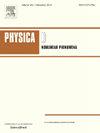湍流速度梯度张量的拉格朗日动力学的群:一种网络参与方法
IF 2.7
3区 数学
Q1 MATHEMATICS, APPLIED
引用次数: 0
摘要
本文提出了一种基于网络的速度梯度张量(VGT)拉格朗日动力学分析框架。每个节点代表一个流状态,链路权重对应于状态之间的转换概率,从统计稳定的各向同性湍流的直接数值模拟(DNS)中得到。该网络通过将VGT连续动力学离散为有限状态集,提供了一个紧凑的表示。我们研究了这种离散化的最佳变量,将VGT状态分类为最能捕捉流物理的组。为此,我们测试了基于拓扑和背景流相干结构的各种特性的几种分类。我们使用“社区”或“模块”的概念来做到这一点,即节点集群,这些节点集群具有最佳的独特性,同时也包含不同的节点功能。最有效的分类,由文献中经常使用的VGT不变量提供信息,结合主不变量Q, R和判别式Δ的符号,区分实特征值和复特征值的区域。我们通过结合从VGT的舒尔分解得出的对熵和应变的非正态贡献的相对量级进一步改进了这一点。考虑非正态性显著提高了分类保真度,并强调了压力Hessian和粘性项对VGT动力学的非封闭和复杂贡献的关键作用。DNS数据与增强的高斯闭包模型之间的比较揭示了传统建模方法在准确捕获VGT动力学的非正态贡献方面面临的挑战。本文章由计算机程序翻译,如有差异,请以英文原文为准。

Communities for the Lagrangian dynamics of the turbulent velocity gradient tensor: A network participation approach
In this paper, we present a network-based framework for analyzing the Lagrangian dynamics of the velocity gradient tensor (VGT). Each node represents a flow state, and link weights correspond to the transition probabilities between states, derived from Direct Numerical Simulation (DNS) of statistically steady, isotropic turbulence. The network provides a compact representation of the VGT’s continuum dynamics by discretizing it into a finite set of states. We investigate the optimal variables for this discretization, classifying VGT states into groups that best capture the flow’s physics. To this end, we test several classifications based on topology and various properties of the background flow coherent structures. We do this using the notion of “community” or “module”, namely clusters of nodes that are optimally distinct while also containing diverse nodal functions. The most effective classification, informed by VGT invariants frequently used in the literature, combines the signs of the principal invariants , , and the discriminant , distinguishing regions of real and complex eigenvalues. We refine this further by incorporating the relative magnitude of the non-normal contributions to enstrophy and straining, derived from the Schur decomposition of the VGT. Accounting for non-normality significantly enhances classification fidelity and underscores the critical role of the unclosed and complex contributions to VGT dynamics from the pressure Hessian and viscous terms. A comparison between the DNS data and an enhanced Gaussian closure model reveals the challenges for conventional modeling approaches in accurately capturing the non-normal contributions to the VGT dynamics.
求助全文
通过发布文献求助,成功后即可免费获取论文全文。
去求助
来源期刊

Physica D: Nonlinear Phenomena
物理-物理:数学物理
CiteScore
7.30
自引率
7.50%
发文量
213
审稿时长
65 days
期刊介绍:
Physica D (Nonlinear Phenomena) publishes research and review articles reporting on experimental and theoretical works, techniques and ideas that advance the understanding of nonlinear phenomena. Topics encompass wave motion in physical, chemical and biological systems; physical or biological phenomena governed by nonlinear field equations, including hydrodynamics and turbulence; pattern formation and cooperative phenomena; instability, bifurcations, chaos, and space-time disorder; integrable/Hamiltonian systems; asymptotic analysis and, more generally, mathematical methods for nonlinear systems.
 求助内容:
求助内容: 应助结果提醒方式:
应助结果提醒方式:


